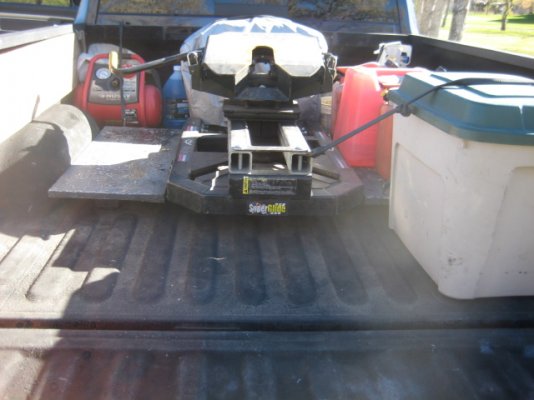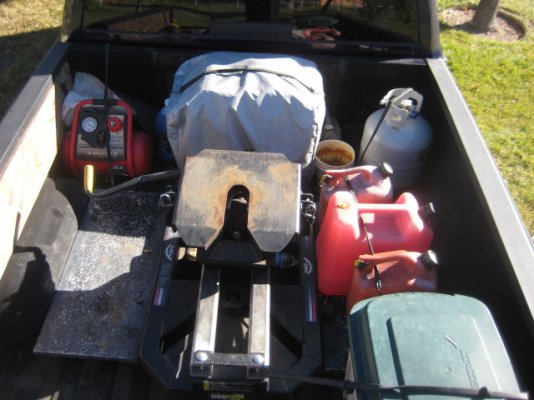Dreamsend
Well-known member
- Joined
- Aug 16, 2016
- Posts
- 614
Got some real numbers from the manufacturer for the actual equipment in the Outdoors RV I'm likely getting. Also, had them measure the tongue behind the LP tanks to get a handle on the feasibility of putting a generator and maybe a gasoline container in the spot. Here is some updated info, and where I think I am now.
Equipment
A/C - draws 14.6 to 15.3 A when cooling, so that's about 15 A average.
Fireplace - draws 11.7 A
Microwave - draws 11.25 A
All of the above of course at 120V. Those are the big ticket items so far.
Converting ---
A/C about 1800 Watts. Surge quoted at 2000 watts
Fireplace - 1440 watts
Microwave - 1350 watts
The trailer has 30 Amp service (3600 watts)
Generator
Honda EU20001 -- rated at 1600 watts running, 2000 surge, and 13 Amp draw, 1 gal fuel tank, no electric start
Weighs 47 lbs.
Honda EU3000 - rated at 2800 watts running, 3000 surge, and 23 Amp draw, 3.5 gal fuel tank and electric start
Weighs 134 lbs.
(I'm using Honda as reference, cause I think most others, Champion, and the blue one etc. will be in the same capacity range for comparable models)
Comparing the A/C to the generators, it's obvious the Honda 2000i is too small. The 3000i would be a good fit I'm thinking. I also like the bigger fuel tank on the 30001. Using 2 Honda 2000i gets me 3200 W, and the 3000i is 2800 W. Yeah I could play around and burden myself with the idea of running JUST one 2000i, but given that you can throttle-down all the models, I'm not gonna be that picky with my operating scenarios.
Neither option looks like it will fit on the tongue behind the LP tanks, BUT, it's very close and I'm certain a carrier could be designed and welded to the frame that would extend the surface area enough to make this work safely and securely with a single 3000i. I'd also like to be able to carry a gas can on the tongue, and NOT in the TT or the truck. I'm not found of the idea of using a carrier mounted on the rear bumper of the TT -- rather have it up front. But with the genny up front, I'll need longer extension cord because the hook-ups on the anticipated trailer are on the rear end! (not the sides). So many things to think about #&*@#!
Being a haz material manager, I don't like gasoline! I worry about things heating up in the HOT sun -- explosive vapors, even IF they claim gas cans are safe.
Any helpful comments about carrying a ~ 3gal. gas can in the truck bed under a tonneau cover? I'm sure many of you have experience with gas cans living full time in your pick-ups in HOT weather.
Also, a 1350 watt straight microwave without convection oven seems awfully big to me. It's not a big deal, just curious. Are microwaves in TT typically that big?
Best to all
Linda
Equipment
A/C - draws 14.6 to 15.3 A when cooling, so that's about 15 A average.
Fireplace - draws 11.7 A
Microwave - draws 11.25 A
All of the above of course at 120V. Those are the big ticket items so far.
Converting ---
A/C about 1800 Watts. Surge quoted at 2000 watts
Fireplace - 1440 watts
Microwave - 1350 watts
The trailer has 30 Amp service (3600 watts)
Generator
Honda EU20001 -- rated at 1600 watts running, 2000 surge, and 13 Amp draw, 1 gal fuel tank, no electric start
Weighs 47 lbs.
Honda EU3000 - rated at 2800 watts running, 3000 surge, and 23 Amp draw, 3.5 gal fuel tank and electric start
Weighs 134 lbs.
(I'm using Honda as reference, cause I think most others, Champion, and the blue one etc. will be in the same capacity range for comparable models)
Comparing the A/C to the generators, it's obvious the Honda 2000i is too small. The 3000i would be a good fit I'm thinking. I also like the bigger fuel tank on the 30001. Using 2 Honda 2000i gets me 3200 W, and the 3000i is 2800 W. Yeah I could play around and burden myself with the idea of running JUST one 2000i, but given that you can throttle-down all the models, I'm not gonna be that picky with my operating scenarios.
Neither option looks like it will fit on the tongue behind the LP tanks, BUT, it's very close and I'm certain a carrier could be designed and welded to the frame that would extend the surface area enough to make this work safely and securely with a single 3000i. I'd also like to be able to carry a gas can on the tongue, and NOT in the TT or the truck. I'm not found of the idea of using a carrier mounted on the rear bumper of the TT -- rather have it up front. But with the genny up front, I'll need longer extension cord because the hook-ups on the anticipated trailer are on the rear end! (not the sides). So many things to think about #&*@#!
Being a haz material manager, I don't like gasoline! I worry about things heating up in the HOT sun -- explosive vapors, even IF they claim gas cans are safe.
Any helpful comments about carrying a ~ 3gal. gas can in the truck bed under a tonneau cover? I'm sure many of you have experience with gas cans living full time in your pick-ups in HOT weather.
Also, a 1350 watt straight microwave without convection oven seems awfully big to me. It's not a big deal, just curious. Are microwaves in TT typically that big?
Best to all
Linda


